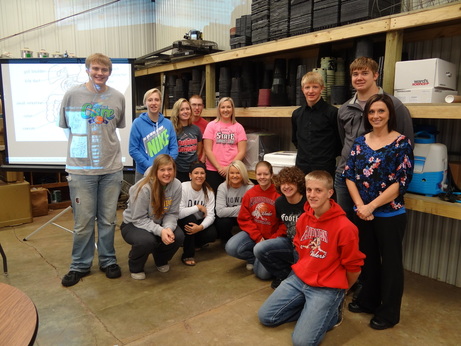By: Molly Armentrout
 Mrs. Elmquist and her Animal Science class began a new project this year of hatching eggs.
Mrs. Elmquist and her Animal Science class began a new project this year of hatching eggs. On the week of September 29th, Mrs. Elmquist and her Animal Science class began raising Japanese chickens from her farm. Japanese chickens are known as ornamental chickens; this means they are raised for looks and not for their meat or eggs.
The class started with six eggs. The eggs sat in the incubator for three weeks on a rotator, to simulate the mother hen sitting on them. Before they hatched, the eggs had to be candled. To candle an egg is to hold a light under the egg to see if it is fertile or how far along the chick is.
When it was time to watch the chicks break out of their shell, Mrs. Elmquist noticed they were having a very tough time hatching themselves. She had her class assist.
“I did not participate in hatching the eggs, just candling them,” junior student Brianna Goecke states.
Only one of the chicks survived the assisted hatching. Mrs. Elmquist named this little chick, Hope. Not long after Hope was looking like she could survive, she drowned herself in her little bowl of water.
Mrs. Elmquist was determined to find out why the chicks couldn’t hatch themselves. She had her class research, and they found out that the incubator wasn’t humid enough, making the shells hard and not soft enough for a beak to break through. Of course, the Animal Science class isn’t giving up though! They now have a fertile duck egg, provided by Mrs. Elmquist, and 5 “mutt” chicken eggs provided by eighth grader, Grace Christensen.
When asked about trying again, Brianna Goecke states, “You learn from your mistakes. [Now we know] we have to keep the incubator humid.”
Mrs. Elmquist tells us, “There is a science to raising eggs and you have to follow the protocol of humidity and temperature. It’s hard to be a mother hen [but it was] cool to see the Animal Science class figure out what went wrong."
The class started with six eggs. The eggs sat in the incubator for three weeks on a rotator, to simulate the mother hen sitting on them. Before they hatched, the eggs had to be candled. To candle an egg is to hold a light under the egg to see if it is fertile or how far along the chick is.
When it was time to watch the chicks break out of their shell, Mrs. Elmquist noticed they were having a very tough time hatching themselves. She had her class assist.
“I did not participate in hatching the eggs, just candling them,” junior student Brianna Goecke states.
Only one of the chicks survived the assisted hatching. Mrs. Elmquist named this little chick, Hope. Not long after Hope was looking like she could survive, she drowned herself in her little bowl of water.
Mrs. Elmquist was determined to find out why the chicks couldn’t hatch themselves. She had her class research, and they found out that the incubator wasn’t humid enough, making the shells hard and not soft enough for a beak to break through. Of course, the Animal Science class isn’t giving up though! They now have a fertile duck egg, provided by Mrs. Elmquist, and 5 “mutt” chicken eggs provided by eighth grader, Grace Christensen.
When asked about trying again, Brianna Goecke states, “You learn from your mistakes. [Now we know] we have to keep the incubator humid.”
Mrs. Elmquist tells us, “There is a science to raising eggs and you have to follow the protocol of humidity and temperature. It’s hard to be a mother hen [but it was] cool to see the Animal Science class figure out what went wrong."
 RSS Feed
RSS Feed